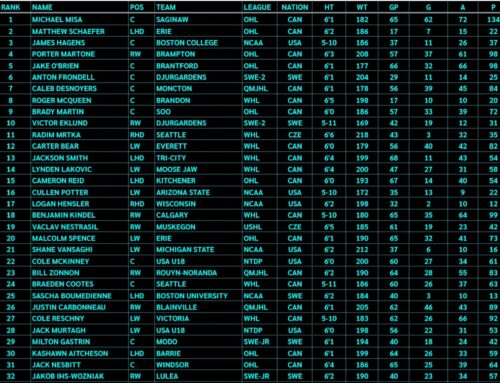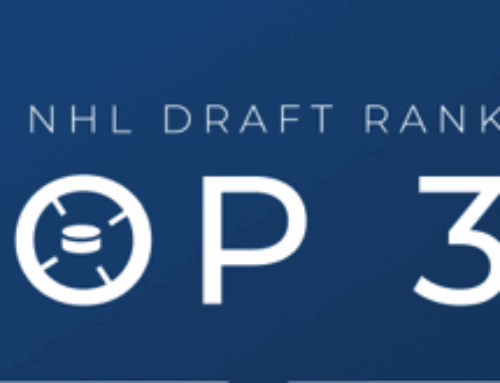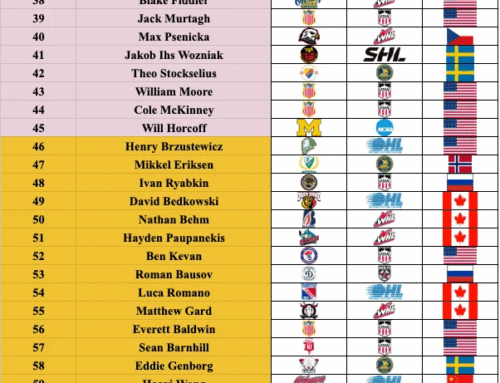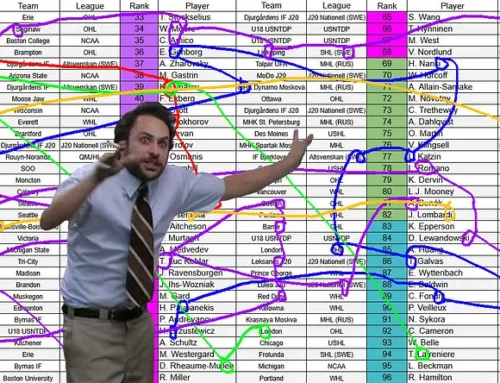PNHLe Organizational Rankings: 31-26
Mason Black
2019-09-10
***
Over the past month, I’ve been re-evaluating, recalculating and re-examining my PNHLe model, which is used to predict a prospect’s NHL point potential in the prime of their career.
With the conclusion of every hockey season comes with it a massive allocation of new data that can be used to make the model more accurate. Many NHL players hit new career highs, while others show consistency in their point production.
Looking back to the leagues they toiled in prior to making the leap to the NHL can give great insight into what a typical point production looks like for many current prospects playing in different developmental leagues.
Simply put, PNHLe tries to gauge a prospects point potential in the NHL. It questions, “If I’m an 18-year old prospect in the OHL who posted a point per game, what does that translate if I make it to the show?” By using current NHL players and how their production translated from their prospect years, we can get a better sense of what to expect from players around the world. PNHLe allows us the ability to compare prospects from different leagues, at different ages and different positions to give a snapshot of just how good a prospect is doing. As a fantasy guru, you can use that knowledge to take advantage and grab prospects before anyone else in your league has even heard a whisper of their names.
Obviously, projecting prospect potential is no easy task. Players develop at different rates and are given different opportunities based on, teammates, coaching deployment and team systems. A single stat like PNHLe is not entirely accurate at trying to predict the ceiling of a player sometimes six or seven years down the road. However, year after year PNHLe develops a trend for a single player that can be used to evaluate the likelihood that they’ll hit their top potential. As a fantasy GM, you can use this to decide when it’s time to cut bait on a prospect that isn’t continuing to develop, or mine a gem that is a late bloomer and has come out of nowhere.
At the 2019 entry draft in June, each NHL team added an average of seven new players to their prospect pool, and in doing so, increased their depth. I thought it would be an interesting activity to evaluate which teams have the best system that could translate into NHL point totals in the near future by using PNHLe.
In order to do this, I averaged their top five prospects to help give a somewhat decent representation of organizational strength. By using an average, a single superstar player can have a larger impact on an entire team’s rankings – see Jack Hughes – which obviously skyrockets the team’s overall value. I arbitrarily chose the top five prospects ranked by PNHLe because at any given time a team probably has somewhere in the range of five prospects that will make a long term impact down the road.
I should mention that these rankings would not correspond to my own personal list of either fantasy or real-life rankings, but is strictly dependent on the PNHLe statistic. You will notice that there are several teams that are much higher/lower than those rankings but I try to explain why that outcome resulted while also taking a look at a few of the prospects from each team.
Without further ado, let us take a look at the rankings!
31st – Boston Bruins – PNHLe: 44.2(Avg.)
There is no question that long-term success at the NHL level over the past decade has left the prospect cupboards fairly empty in Boston – especially on the top shelf. This is a common theme with many of the teams listed at the bottom of today’s league rankings.
It’s not to say that the Bruins are lacking in the quantity of prospects with NHL potential. On the contrary; a huge part of the reason Boston has been a perennial Stanley Cup contender is that they have done a masterful job of finding exceptional players to fill holes in their line-up year after year, and have locked down their star players to very reasonably priced contracts. Their top-six is fairly locked down and the remaining holes in the roster are easily filled with players that can slot up and down the line-up.
However, the Bruins are lacking a true game-breaker, and although I think Studnicka will be an NHL regular for a long time, I don’t foresee him rounding out as a top line player. Recent first round acquisition, John Beecher, is cut from a similar mould. Overall, I don’t think the Bruins’ prospect pipeline is last in the league as they have some very intriguing prospects that are nearly ready to contribute in the NHL, but their average PNHLe does paint a fairly clear picture of the lack of top end talent. Fortunately, Boston doesn’t exactly need that type of player at any position.
30th – Tampa Bay Lightning – PNHLe: 46(Avg.)
Tell me if you’ve heard this one before – a team with immense talent that regular finds themselves at the top of the standings finds their prospect pool nearly devoid of game-breaking talent? That’s why the Lightning find themselves near the bottom of these PNHLe rankings, however one key component is missing compared to many of the other teams that are also near the floor of this list: a Stanley Cup ring (at least in recent memory).
It seems as though every season Tampa Bay has a new roster player that has the rest of the league buzzing about who they are and where they came from. Their pipeline is littered with players that have a high degree of talent but don’t necessarily carry the draft pedigree with them. These are the Yanni Gourde’s, Tyler Johnson’s, Johnathan Marchessault’s and Brayden Point’s that continue to find huge success in the Florida panhandle.
Alex Barre-Boulet was a free agent signing that quieted many doubters, including myself, by picking up AHL rookie of the year honours. I’m personally bullish on Gabriel Fortier, Tampa’s first selection from the 2018 draft. He seems to me to be the prototypical Lightning forward that will have many shaking their heads wondering how he ever slipped to the end of the second round. I would expect Nolan Foote’s numbers to increase significantly as he learns to utilize his big frame at the junior level and tries to improve his skating deficiencies, much like his brother. Tampa Bay are fortunate that they have multiple game-breaking players at each position, and for the foreseeable future only need to fill holes with players on cheap contracts and their prospect pool is littered with those. It should allow them to have multiple opportunities at getting over the hump and perhaps even the biggest prize of all.
29th – Winnipeg Jets – PNHLe: 47(Avg.)
For a significant amount of time the Winnipeg Jets were at the top of the class in terms of their prospect potential. After a few years of consistent graduation of these players the Jets now find themselves at the bottom looking up. I’m sure management would be more than happy if their previous prospects’ potential would translate into playoff success, but unfortunately that has yet to happen in Manitoba.
After some significant changes almost exclusively to their defensive corps to help alleviate cap trouble, the Jets now need to rely on a fresh crop of young players to fill the holes left in the line-up.
Winnipeg does have a couple of very talented players on the way, including Kristian Vesalainen who I see as an eventual top-six winger in another couple of years. He bounced around a few different leagues this year and this contributed to knocking down his overall PNHLe. This year’s first round selection, Ville Heinola, is a slick offensive defenseman, but still a few years away from making any sort of impact at the NHL level. He will be best served by continuing to develop in his homeland playing in the Liiga.
The Jets’ are in a bind with respect to the salary cap, and have a few big names coming up as free agents over the next several years, including this year. It is going to be very important that GM Kevin Cheveldayoff locks these players up and is able to get production from the graduating prospects that earn roster spots.
28th – Washington Capitals – PNHLe: 50.4(Avg.)
If I were to rank the top organizations without looking at PNHLe, the Capitals would probably be in the bottom two or three. Again, the former Stanley Cup champions can look up and laugh due to the fact that their hands got a little heavier now that they have to carry an extra ring a couple of years ago.
With a top-six that is practically etched in stone, Washington doesn’t necessarily need top-end talent cluttered throughout their pipeline. That probably played a large part in why they selected Brett Leason with their second round pick in the 2019 draft. He doesn’t have top-line talent, but was one of this year’s most NHL-ready draft eligible prospects. Similarly, their first round pick, Connor McMichael, doesn’t play a flashy style, but instead brings all-around skill without any glaring holes in his game.
Washington needs to graduate prospects that can fill holes and play specific roles and their pipeline is fit to fulfill that need. The Capitals’ scouting staff has clearly established a framework for finding future success and now it’s time for the organization to trust their top players and use their experience if they are to bring home another Cup in the near future.
27th – St. Louis Blues – PNHLe: 51(Avg.)
Has the hangover subsided yet? The Blues hope it lasts just a little bit longer.
In another world, one can only imagine if the last place NHL team at the beginning of 2019 stayed with the status quo, finished outside of the playoff picture and are now sitting towards the bottom of prospect rankings. It would certainly be a much different off-season in St. Louis. Instead, the Cup champions will boast a very similar roster heading into 2019-20 as they did while skating Lord Stanley around Beantown.
That leaves very little room for any prospects looking to make the jump to the NHL full-time. There is, however, one exception: Jordan Kyrou. Although there is limited space on the roster, I don’t see any way that Kyrou won’t find his way into a blue and yellow jersey in St. Louis to start the season. He’s simply too good of a player, and has top-six talent written all over him. Outside of Kyrou, the rest of the Blues’ systemic depth is fairly well depleted.
I’m a fan of Scott Perunovich, and Tyler Tucker took a big step in terms of his development, but from a fantasy perspective I’m not sure there are enough drool-worthiness in their game to get too excited over. As crazy as it may sound, it wouldn’t be too shocking to me to see the Blues battling it out for the last playoff position in an increasingly strong Central Division. St. Louis will need to rely on the experience they gained from last year’s amazing story to overcome any adversity, including that nasty headache that could slow them down out of the gates.
26th – Columbus Blue Jackets – PNHLe: 52.6(Avg.)
You have to give the ‘Brass Balls’ award last year to GM Jarmo Kekalainen as he went ‘all-in’ with a team that was still in a battle to get inside the playoff picture at the trade deadline. And it worked, at least in part, as they snuck into the post-season as the eighth seed only to sweep the best regular season team and win their first ever playoff round.
Yet the cost of that success was rather huge in terms of draft picks and prospects. What remains are a few key pieces that have the potential to contribute in the near future, but none of which possess first-line talent. I’m a fan of Alexandre Texier who has had an atypical pathway to the NHL but found himself playing a playoff role in his NHL debut. Emil Bemstrom has flown under the prospect radar but truly broke out last year and should be a household name at the culmination of this upcoming season.
Despite losing star talent after the conclusion of their playoff run, the Blue Jackets may have enough core pieces to make another push into the post-season provided they get steady goaltending from their unproven netminders. In another couple of years, names like Liam Foudy and Andrew Peeke could become regular contributors in a depth role. However, without any future stars in the pipeline, Columbus will need to tap into the grit they used in last year’s final couple of months if they are to find the success to push them farther than a first round win.
***
If you’ve enjoyed today’s breakdown of using PNHLe to predict a prospect’s future success at the NHL level, please stay tuned as I complete an article once per month here at Dobber Prospects, while also covering the players in Vegas Golden Knight’s system.
I’ve also created the NHL Rank King app where you can find full organizational point totals for prospects, PNHLe rankings among many other fantasy resources. I consult the app on every fantasy hockey decision I evaluate and every feature added to the app is with the sole purpose of helping with the choices surrounding my fantasy hockey teams. It’s completely free, so hopefully you will find it useful as well!
You can download the iPhone version here, and I’ve recently created an Android version as well.
If you are on Twitter, please give me a follow @NHLRankKing.
Mason Black













